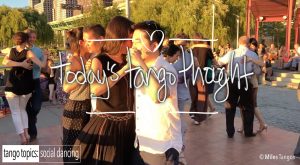see > ‘giving and receiving feedback‘
Receiving Feedback is as insanely important as giving it.
Here’s how you do it.
Ready ?
SHUT UP.
STOP TALKING.
LISTEN.
Let the other person speak, and/or demonstrate what’s going on for them. Do not interrupt. Do not engage in defending your position. Don’t get defensive. Do not let your ego get in the way of hearing what you need to hear right now. One of the best things that you can do for you, and the people that you dance with is be humble, gracious, kind, clear, and most of all be quiet when receiving feedback.
To be clear, listening is a highly undervalued skill in today’s world, we want to talk so that we can confirm that we’re on the right page and to seem like, as if, we’re knowledgeable. You do not want to do this. Instead use your ears, use your eyes, be silent, and listen.
At the same time, it wouldn’t kill your ego to ask for feedback now and again. And while most Followers do this, not enough Leads engage in this practice.
Engage in the active practice of asking for feedback, and then…here’s the hard part – RECEIVE it!











